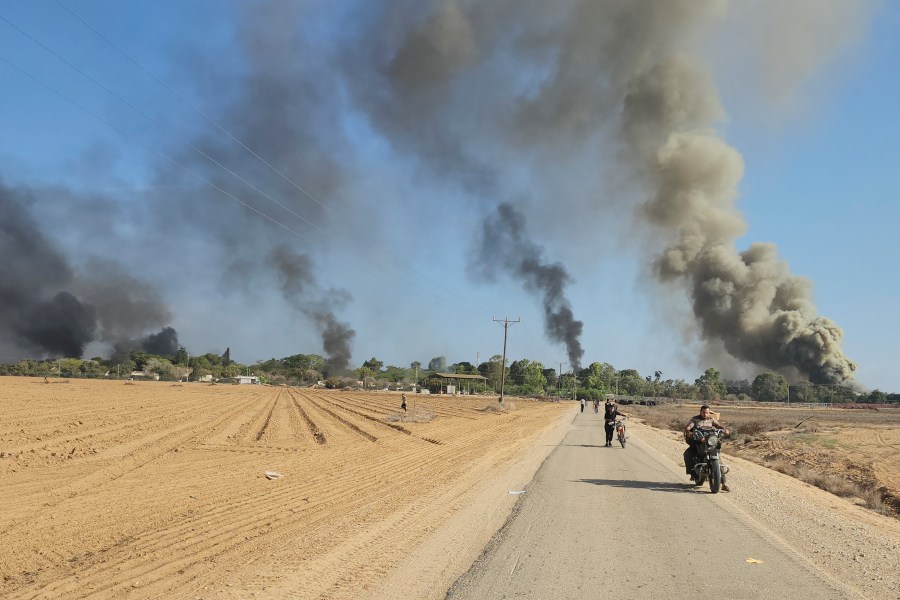Just In News | The Hill
Iran and Hamas pried Pandora’s Box wide open on Oct. 7 by unleashing a heinous wave of rocket attacks and assaults on Israeli cities and villages. This was likely done with Russian President Vladimir Putin’s tacit approval, if not direction and planning. What had been chiefly a localized threat to Jerusalem – Hamas in Gaza, Hezbollah in Lebanon and Syrian and Iranian troops along the Golan Heights – is now an existential threat to the state of Israel on a regional and global scale.
Hamas’s goal, stated in its founding covenant, is the destruction of Israel, and its inexorable pursuit of an Israeli Armageddon must now be taken at face value by Prime Minister Benjamin Netanyahu and his national unity government. Especially after the reign of terror Mohammed Deif, Hamas’s military commander, unleashed in Kfar Aza, Sderot and at a music festival on a scale that the Jewish people had not witnessed since the end of the Holocaust.
Israel cannot risk waiting to eradicate Hamas. Not after NBC News reportedly obtained documents marked “top secret” in Arabic outlining “plans to target elementary schools and a youth center in the Israeli kibbutz of Kfar Sa’ad.” Not after images of slain Israeli children have spread across mainstream and social media. And not as Tehran nears enriching sufficient highly enriched uranium to begin producing nuclear weapons.
Jerusalem has stated that it will take out Hamas, like ISIS was taken out. In time, Iran will also likely face Israel’s retribution. Netanyahu and his government cannot allow Deif or Ali Khamenei, Iran’s supreme leader, to allegorically-speaking reach the gardens of Armageddon — and potentially deploy nuclear or bioweapons later against the Jewish state.
For now, however, forcibly retaking Gaza is the Israel Defense Force’s (IDF) likely primary objective.
It will not be easy.
Hamas has predicated its self-defense on a suicide pact that is has enforced on Palestinians living in the Gaza Strip. By Deif’s design, no Palestinian civilians are safe from Hamas. Men, women and children will be willingly sacrificed as human shields in the looming street-to-street and tunnel-to-tunnel battles with the IDF — as evidenced by Hamas’s rejection of Israel’s evacuation order of upwards of 1.1 million Palestinians living in Gaza City.
United Nations Secretary General António Guterres was quick to object to the order, and in a New York Times op-ed urged Israel to “reconsider,” while reminding the IDF that “international humanitarian law — including the Geneva Conventions — must be respected and upheld.” Israel is not relenting and has begun a series of localized ground raids inside the Gaza Strip.
Israel is losing the information war. It is imperative it does what Hamas callously refuses to do and immediately implement measures to minimize Palestinian suffering and loss of life. It must create safe corridors, temporary refugee camps and provide for medical and other forms of humanitarian aid to displaced Gazans. Jerusalem must also continue to diplomatically engage regional and global partners in addressing the deepening humanitarian crisis that Deif and Hamas have caused.
The IDF faces a daunting fight in Gaza. Hamas’s forces (alongside those of the Palestinian Islamic Jihad (PIJ), Al-Aqsa Martyrs Brigades, Democratic Front for the Liberation of Palestine, Palestinian Mujahideen Movement and Popular Resistance Committees) are well trained and equipped. Israel’s elite air force special operations team, known as the Shaldag Unit, found that out, suffering “heavy casualties” combatting Palestinian terrorists who had killed more than 100 Israelis at Kibbutz Be’eri.
The IDF learned from its bloody and costly encounter with Hezbollah during the Israel Lebanon War in 2006 and Operation Protective Edge in 2014, the IDF’s 50-day incursion into Gaza. In 2006, fighting in and around Bint Jubayl turned hand-to-hand in street-to-street fighting. Lt. Gen. Herzi Halevi, Israel’s chief of the General Staff, knows what the country is up against in Hamas and its “ruthless terrorists,” and has likely factored in military lessons and stratagems learned from the ongoing war in Ukraine.
Netanyahu and his government’s stated goal is to “wipe Hamas from earth,” and the Israeli prime minister has personally avowed that “Every Hamas member is a dead man.” To achieve both, Israel will have to be innovative in how it proceeds with its ground incursion into the Gaza Strip. Late Saturday night, IDF Rear Adm. Daniel Hagari said during a nationwide telecast that Israel will “broadly attack Gaza City very soon.”
Any ground assault into the Gaza Strip will likely be slow and deliberate. Hamas has prepared for this scenario for years. Hardened underground bunkers and tunnels afford subterrain movement, and recently destroyed buildings provide excellent dismounted fighting positions and cover for the defenders.
IDF forces will likely partition the Gaza Strip into manageable objectives, with assault forces mutually supporting one another to seize and secure each objective — similar to the military tactics employed by the U.S. Army in Fallujah, Iraq. Tanks in an urban environment are vulnerable, as such they will likely be used to support dismounted infantry as they clear buildings.
The cost in manpower will be high as forces must remain behind in secured areas to ensure Hamas militants cannot infiltrate and attack IDF rear areas through their extensive tunnel networks. Israel’s present troop level mobilization of 360,000 may not be sufficient to conduct a ground operation in Gaza while defending threats from Lebanon, the West Bank and other regional actors, including Iran.
The urban fight will be different this go-around. With the introduction of unmanned aerial vehicles and mechanized ground robots, exposure to hostile fire can be mitigated. Reconnaissance drones can identify Hamas battle positions and activity, deliver and direct fire upon them and provide overwatch as IDF soldiers secure buildings. Communications, from the strategic to the tactical, is imperative.
But Hamas is not alone in this fight, nor in its desire to bring about a symbolic Armageddon-like end to Israel. Unrest is swelling in the Palestinian Authority-controlled West Bank. Hezbollah is active in armed clashes along the Lebanese-Israeli border. And Tzachi Hanegbi, Netanyahu’s national security adviser, has warned Hassan Nasrallah, the head of Hezbollah, to stay out of the war, lest it result in the “destruction” of Lebanon.
Iran and its fast-growing nuclear threat loom to the east as well. If confronted with losing its Hamas-Hezbollah deterrence – especially in terms of protecting its nuclear weapons program – Tehran could opt to militarily strike Israel directly or indirectly via Syria, or both. As the Voice of America reported last Thursday, “Foreign Affairs Minister Hossein Amirabdollahian warned that Tehran’s allies in the region could take action against Israel.”
Meanwhile, regional tensions are intensifying. Amirabdollahian met with Hamas political leader Ismail Haniyeh in Qatar on Saturday. And, according to reports, the U.S. dispatched the “USS Eisenhower carrier strike group to join [the] USS Ford” in the Mediterranean.
Israel views any ending to itself as a modern Jewish state to be the equivalent of Armageddon, an unacceptable end-state. Consequently, Jerusalem is now existentially regarding Hamas’s multi-domain sea, land and air assault on Israel and its civilians as a march to Armageddon that must be stopped at all costs.
Mark Toth is a retired economist and entrepreneur who has worked in banking, insurance, publishing, and global commerce. He is a former board member of the World Trade Center, St. Louis, and has lived in U.S. diplomatic and military communities around the world, including London, Tel Aviv, Augsburg and Nagoya. Follow him on Twitter @MCTothSTL.
Jonathan Sweet, a retired Army colonel, served 30 years as a military intelligence officer. His background includes tours of duty with the 101st Airborne Division and the Intelligence and Security Command. He led the U.S. European Command Intelligence Engagement Division from 2012-14, working with NATO partners in the Black Sea and Baltics. Follow him on Twitter @JESweet2022.
International, Opinion, Israel-Hamas conflict, Israeli-Palestinian conflict Read More
Author Profile
Latest entries
 HeadlinesSeptember 20, 2024Cornell professor who praised Oct 7 Hamas attack joins another anti-Israel protest on campus
HeadlinesSeptember 20, 2024Cornell professor who praised Oct 7 Hamas attack joins another anti-Israel protest on campus ScienceSeptember 20, 2024What do young voters think about the 2024 election?
ScienceSeptember 20, 2024What do young voters think about the 2024 election? HeadlinesSeptember 20, 2024‘Bachelorette’ finalist Devin Strader addresses past arrest reports: ‘I know that I have made mistakes'
HeadlinesSeptember 20, 2024‘Bachelorette’ finalist Devin Strader addresses past arrest reports: ‘I know that I have made mistakes' ScienceSeptember 19, 2024Deadly snail venom could make diabetes medicines better
ScienceSeptember 19, 2024Deadly snail venom could make diabetes medicines better

